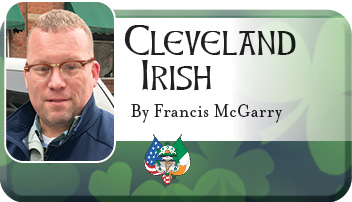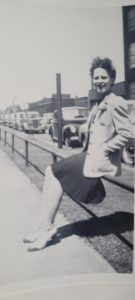
 Cleveland Irish: Ward 27, 1940
Cleveland Irish: Ward 27, 1940
By Francis McGarry
My Grandma Grace meet Florence while they attended a series of priestly talks at St. Aloysius. Florence would attend with her soon-to-be husband, Louie. Louie was French and a friend of the working man. You had to call him Louie.
If anyone called him Louis, he was overtaken by memories of Bastille Day, even though he wasn’t born yet, and could not hold his tongue nor suppress his profanity. Coach Holtz said profanity only illustrated lack of discipline and lack of vocabulary. Well, for Louie it illustrated what happens when you call him Louis.

Check Please
At one of the priestly talks as the three of them sat together, a young fella was trying with my Grandma Grace. That is not surprising since she was a Willard Lovely during the war. It would appear this fella was a proper gentleman and asked her to go for a sandwich and a beer after the priest was done with his lecture.
Grandma Grace accepted as long as her friends could also partake. They had a pleasant time and the young fella excused himself to go to the men’s room. It was during that moment Louie revealed he was running low on cash flow; the conscious was there was not a dime among the three of them. Times were hard in the streets of the Eastside. My Grandma Grace dined and dashed with Florence and Louie.
Toussaint
Grandma Grace admonished me to never do such a thing, in part because the young fella was at the St. Aloysius priestly talk the next week, awkward. She also advised me, “If you want a good life, find a nice Jewish family to work for.”
Louie and Florence adhered to that advice. They were hired as the butler and cook, respectively, at a home up Cedar Hill. On the first day, Louie was in his butler uniform and began to serve dinner to the family. Florence had carefully prepared the dinner. Biscuits were carefully arranged on a large silver tray poised on Louie’s left hand.
As the lady of the house reached for a biscuit, she questioned Louie in her aristocratic shrilly voice, “Louis, what are these?” Well, Florence was doing the best she knew how, but failed to include baking soda in the biscuits. Louie eluded verbal restraint and invoked Marius, but there was no Jean Valjean to save him. They never made it to dessert.
Lincoln Electric
Grandma Grace had worked for a Jewish family after she graduated from John Hay, before Jesse Owens and before Irish Club Co-Member of the Year Michael Byrne graduated from Cathedral Latin located across the street. She got a job during the war at the Willard Plant in Ward 27. Willard was just south of Kirby Avenue and west of 131st street, or for you I-90 folks, just southeast of the Bratenahl PD speed trap at the Eddy Road exit.
John Francis, my grandfather, worked two factories north of Grandma Grace at the National Acme plant during the war. In 1940, that area was bordered on the north by the Lake Shore and Michigan Southern line and east by the Cleveland short line of the New York Central Railroad.
If you crossed the tracks to the east, you were no longer in Cleveland. Lincoln Electric, National Acme, Steel and Tubes, Weatherhead, Willard, Briggs Manufacturing, Hamilton Steel, Enamel Products, Lake Erie Steel, Hupp Motor Car and Tremco Manufacturing were all adjunctly located there with the Foote-Burt Company just across St. Clair Avenue.
Just east of the St. Clair and Shaw Avenue fork and directly east of Foote-Burt, was the Cleveland Railway Company and the St. Clair Avenue Yards. The B’nai Jeshurum Cemetery of the Hungarian Congregation had a footprint close in acreage to its neighbors, the Railway and Foote-Burt.
It is one on the three religiously affiliated properties in the entire ward, depending on your opinion of the East Glenville M.E. Church and a small building owned by the Church of Christ. If you recall, in Ward 24 you had holy land in every direction. St. Aloysius, at 110th, was the last place of worship heading east until you left city limits.
Cemeteries don’t indicate ethnic population density like places of worship, especially with the modes of transportation and spatial paradigm of 1940. There was no I-90. The demographics of Ward 27 are similar to Ward 24, directly to the west. Comparatively Ward 27 had roughly 8,000 fewer inhabitants, yet still relatively large numbers of native born Eastern Europeans. Presumably many of them were Jewish, utilizing place of worship heuristics. That also agrees with both world history and development of the City of Cleveland.
Place of Birth Ireland
There were ninety-four people in Ward 27 who listed Ireland as their place of birth. Their households totaled 186 inhabitants of the ward. That does not count spouses who were not born in Ireland, although it is probable that the spouse was of Irish ancestry. My calculations are conservative.
Those calculations tabulated 998 citizens that were native born Irish or had an Irish surname that was clearly Irish. Brannons, Dowds, Murphys, Mullins, Jamisons, Madigans, O’Briens, Fitzgeralds, Gallaghers, Lallys and Boyles made the cut.
It was also clear that those declared to be of Irish ancestry were more likely to live in clusters. At least 121 people with Irish blood lived on East 120th Street, at least seventy-two on Woodside Avenue and at least sixty-five on Eddy Road. In all fairness, Eddy Road is a lot of road, but the majority of the Eddy Road Irish were neighbors and East 120th is just two city blocks long before it becomes Thornhill Drive. If you lived on East 120th your backyard was abutted to the backyards of those who lived on Eddy Road.
Ward 25 is the third of the three wards that are circumjacent to St. Aloysius. That data should assist in illustrating the community demographics of the parish. St. Aloysius was the last Irish parish on the eastern frontier of the City of Cleveland. The next migrations were to Collinwood and East Cleveland, which had already begun in 1940, and then to Euclid and the Heights.
Google Maps inverts that migratory path when I travel from the Heights to I-90. Until this article, I did not know it directs me past the Willard plant that Grandma Grace worked at during the war. Thankfully, it steers clear of the bar she dined and dashed at; in case they hold a grudge like Irish folk.
*Francis McGarry holds undergraduate degrees from Indiana University in Anthropology, Education and History and a Masters in Social Science from the University of Chicago. He is the founder of Bluestone Hibernian Charities. Francis is a past president of the Irish American Club East Side. He is the founder and past president of the Bluestone Division of the Ancient Order of Hibernians.

Monthly newsmagazine serving people of Irish descent from Cleveland to Clearwater. We cover the movers, shakers & music makers each and every month.
Since our 2006 inception, iIrish has donated more than $376,000 to local and national charities.
GET UPDATES ON THE SERIOUS & THE SHENANIGANS!